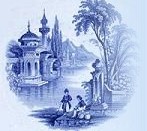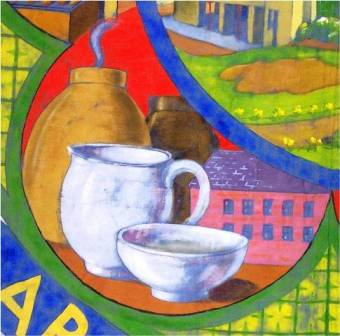




AGE
Q. What age you were when you started work?
A. I would be about 15. It was a normal age for you to start working when you left school.
Q. How long were you in that job?
A. About 4 years.
PAY
Q. What was your first pay?
A. We were paid weekly, 6 shillings and tuppence one week and 6 shillings and seven pence the next week. Once you learned your
trade, you made your own wage. You got so many dishes to do and if you finished them all you got so much for the dozen, a piece
rate: a dozen was 36 then and you could make £1.00/£1.05s. On payday, we all gathered outside the office and you got your pay in a
cup. It was one of these bisque cups before they were glazed. I suppose instead of throwing them out or breaking them they'd keep
them to put the pays in. They shouted your number and you went forward and got it.
Q. Was there any overtime or bonuses?
A. I don't remember any overtime.
Q. Did you get a reduction on pottery?
A. You did get it a little cheaper if you got it in the potteries.
Q. Was it a good wage?
A. We just got by with it.
Q. How did it compare with other potteries?
A. I think the wages were round about the same, even in the hosieries.
Q. Did you receive any pay rises?
A. We just went on piece work. We made your own wages.
Q. Did you have to supply any equipment or clothing?
A. Just our overalls.
HOURS
Q. What hours did you work?
A. We clocked in at the office at 7 o'clock and finished at nine, we started at 10 o'clock and finished at one till two and then we finished
at half past five. We had to work till 12 o'clock on a Saturday.
Q. How did you get to work?
A. Walked.
Q. What happened if you were late?
A. They quartered you if you were late; maybe a sixpence.
Q. Were there any breaks?
A. We had no breaks.
Q. How did you know when to go for your lunch?
A. The horn blew.
HOLIDAYS
Q. Were there any holidays?
A. We got a week’s holiday, unpaid. I went away to Rothesay or somewhere like that.
Q. Were there any customary works outings?
A. No.
WORK
Q. Exactly what work did you do?
A. I was a gilder. That meant painting the dishes, putting the gold on the handles and round the edges of the cups. We had
aerographed ware too. It was brought up to our place after it had been aerographed. It had a stencil on it and they waited until it was
dry, then it came up to us and we finished it off. We painted round the stencil part and put the gold line around the side.
Q. What types of things would you be painting?
A. Flower pots, and then we had transfers on cups and tea sets. The transfers were coloured and came in a big sheet and you had to
cut them out. Usually they would go on all right but sometimes you had to scrape them off if they didn't go on right and start again.
Q. How would you put a transfer on?
A. You got a drop size first of all and put it on your cup or saucer then you cut out your transfer and stuck it on. You got some water
and with a sponge you wet the transfer and then waited for a wee while until you knew the transfer had taken. Then you took it off and
you got a bit cotton and padded it so that it was all smooth. After we did that, it was put in the muffle; that was an oven. Then you put
the gold round about the edge and on the handle. We got a long board with a trestle and you sat there working. You had your wheel
and the board and you put your dishes on that and after you had your 36 cups and saucers you put them up on this thing that had sort
of shelves on it. You just slipped your board in. We used to work with things like crows feet, three pronged, and you put them in your
plates to keep them from sticking.
Q. How did you put the gold round?
A. We had a block and it had a ring on it and you put your cup or your saucer on that and then you had to centre it. You had a rest, to
rest your arm, your brush and your paints. You made sure that it was centred and put your gold ring round about the edge by turning
the ring on the block.
Q. Was it very difficult to get an exact line?
A. You had to learn it for a very long while but as long as you had it centred and you knew how to use your brush it was all right. You
got different sizes of brushes for the lining including one with a long edge on it.
Q. Were the brushes supplied to you?
A. Yes.
Q. Where did the lining gold come from?
A. They sent away for it. It came in wee bottles. We just took it out the bottles, the gold anyway, but the paints we had to mix up. We
had a charge hand in the place and he mixed them up for you, then when you wanted a different colour you got it from him. He was a
lovely painter and it was him that trained you. Once you were trained, you went on piece time and then you made your own pay.
Q. You mentioned they burned the rags, why?
A. To get the gold off them. I used to throw mine in the bucket.
Q. Would the ware have been glossed?
A. That's right.
Q. How many cups could you do in a day?
A. 72. It depended on the pattern you were doing, but it was easy enough to line them with gold.
Q. What was the hardest part of your work?
A. Transfers, well the longest part.
Q. How good was the quality?
A. Quite good, quite nice. We usually put our number on them. My number was one and you put that on the bottom. There was never
anything came back, because when we were doing it, if it wasn't done right we just broke it. Mr. Lumsden and our boss, Mr. Graham,
did lovely painting. He was a specialist. If someone was wanting a cup for a birthday or silver wedding he would write the name on the
cup.
Q. What happened to the things that were made, when you were finished with them?
A. They were put through the muffle and then they were taken into the glost warehouse and then they were sent away for orders to all
the different places.
Q. Did any factors affect when you could work?
A. No, we just carried on.
Q. Were there any changes?
A. Not that I know of.
Q. Were all the gilders women?
A. Yes, except Mr. Graham. There were about 8 or 9 gilders.
TRAINING
Q. What training did you receive?
A. The man told us what to do. At first, when I started there, you got a black tile and a knife and you had to grind it until it was smooth.
It was paint, a powdery paint.
Q. Then you went on to the gilding?
A. Yes, transfer and that, then the lining.
Q. How long did your training last?
A. About 6 months. There wasn't much to do to train, as long as you knew how to keep a steady hand for the painting and as long as
you centred your dishes.
Q. When you were being trained were you on a lower wage?
A. No, you still got the same wage.
Q. Was there any opportunity for promotion?
A. No. I think that the gilding shop was the best job.
TOOLS/EQUIPMENT
Q. What tools did you use?
A. Just brushes, ordinary wee brushes and there was a long styled one for doing the edges of the dishes.
MACHINERY
Q. What machinery did you have?
A. Just a wheel and it had a bottom on it and you just burIed it round. You had a block to put your cup on but if you had a plate you
didn't use the block. You always had to centre them because you didn't get the line on unless they were centred.
Q. Was it reliable?
A. Oh, yes.
CONDITIONS
Q. What were conditions like?
A. They were all right.
Q. What were your lighting levels like?
A. You had an electric light hanging from the roof.
Q. What was the temperature like?
A. You had a great big radiator. I think it was heated with steam because you had the big fire doors down at the bottom of the yard as
you came into the pottery. We went up these wee stairs. There were different departments, but our shop was right away at the top and
you went up the wooden stairs to get to it. There were toilets at the bottom of the yard you had to go down to. Our job was a clean job
just working with the paint and you could go and wash your hands as there was a well at the bottom of the stairs and a big trough. It
was right old fashioned.
Q. Were there any safety measures, or inspections?
A. Maybe in the jolly shop.
Q. Were there first aid facilities?
A. Just a wee box for bandages and things. I remember it hanging up in the office.
Q. How did you get your refreshment?
A. You just went home.
Q. What was the general atmosphere like?
A. Very good. Everybody was great. All you spoke about was the dancing and things like that. We learnt to dance the fox trot during
working hours in the pottery when we had a wee bit time off. Somebody would look out for the boss coming.
Q. Did you ever get caught?
A. No, and we enjoyed ourselves.
ACCIDENTS
Q. Were there any dangerous substances?
A. I worked in the jolly shop for about a week. It was an awful job and it was that hot up there. You were running the dishes into the
ovens and if you got that clay on your arms… I came out in a big rash, so I asked if I could get a shift to another job and that's how I
got to the gilding shop. With the machinery and everything going, it was worked with electric, it was really hot going into the ovens.
EVENTS
Q. Were there any notable events at your work that affected you?
A. Before the Duke of Windsor abdicated we did a lot of mugs and things for his coronation but they were never sold and I don't know
where they went to.
Q. What did you put on them?
A. It was a transfer with his coat on it.
Q. Was there any edging on that?
A. Gold edging.
Q. Round the rim?
A. Yes, that's right and on the handle, but I don’t know what they did with them because we did quite a few of them thinking he was
going to be crowned king. It was a white mug with a transfer.
Q. Was it a colour transfer?
A. Yes.
Q. Were they stamped at all?
A. No.
LIKES
Q. Was there anything you particularly liked about working there?
A. I enjoyed the gilding shop.
STORIES
Q. Do you have any memorable stories?
A. We used to clean up all our benches on a Saturday morning. Then we would wet our hair and Isa Grant, she was good at doing the
hair, would set it ready for going to the dancing.
Q. During your work?
A. Yes.
FAMILY
Q. What did your father do?
A. He worked with the Electricity Board.
Q. Was he a miner before that?
A. Yes, in Kinneil in Bo'ness and two or three other pits when he was younger.
LEISURE
Q. What did you do for leisure?
A. We went to the dancing a lot. We went to Gardeners and the town hall, there were two dance halls then. We used to get a bus up
for trips to Gullane and we would go for walks out the Grangemouth Road or up Linlithgow Road or up Kinneil on a Sunday.
Q. Did it cost to get into the dancing?
A. Yes, it was about tuppence ha'penny or four pence.
Q. Were there any sports clubs?
A. You could play badminton or you could play tennis at the tennis courts.
Q. Were there any societies?
A. There was the Co-operative Society. We all went there once a week and once a year we went on the stage. We were in different
plays like Cinderella.
Q. Was the church an important part of community life?
A. Yes. I went to Carriden church and I become a member when I was 18.
Q. How did you celebrate special occasions, like a wedding?
A. You went to the church and the reception, that was all.
Q. If it was your birthday?
A. You got a present.
BO’NESS
Q. What was Bo'ness like at that time?
A. There was a lot of work like wood yards and hosieries, and at one o'clock when you were coming from your work there were women
coming from the hosieries and the wood yards. One o'clock was the main break time. It was a busy place then.
Q. What amenities were provided in the town. Were there rubbish collections?
A. Yes. At that time it was all coal fires and the people put their buckets out and they came and collected the ashes.
Q. Did you have street lighting?
A. At first it was gas lighting then it was electric after that.
Q. What shops were there?
A. There was Wevling’s, and Oliver's, the same as what it is just now. The town's just the same.
Q. What kind of transport did the town have?
A. Well, you had the buses just like you have the now and there was a train. You got the train to Glasgow.
Q. How much would it cost for the buses?
A. It was seven pence to get up to Grangemouth return, and it was eleven pence to get up to Falkirk return.
Q. Can you remember what the Fair was like?
A. Just the same. We had to walk round the town as there weren't motors. I remember being at Kinneil one time. The crowning was
there and we got our bag with our cookie and our banana in it in the park at the Kinneil estate. I think it was at Kinneil. Well before my
time it was held there. It changed into where it is the now.
THE END
MARY BOYD
In the late 1980s Central Regional Council undertook a series of interviews with several of the area's senior citizens who had worked in
the various local industries. By the late 80s some of these industries no longer existed and pottery production was one that had
already been confined to history.
An insight into the pottery industry is given in the following interview with Mary Boyd. Mary was a gilder and worked in Bridgeness
Pottery from 1933 'til 1938 and returned fifteen years later for a second spell in 1953.